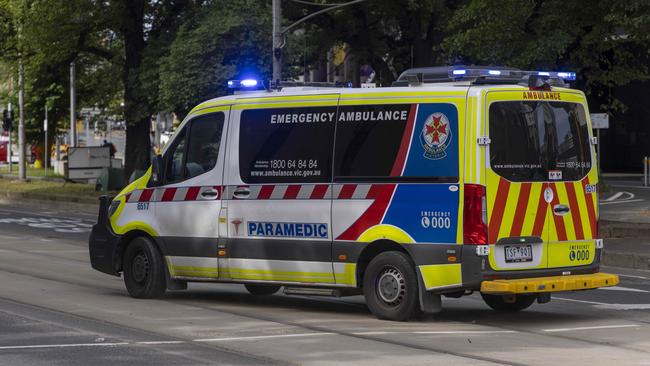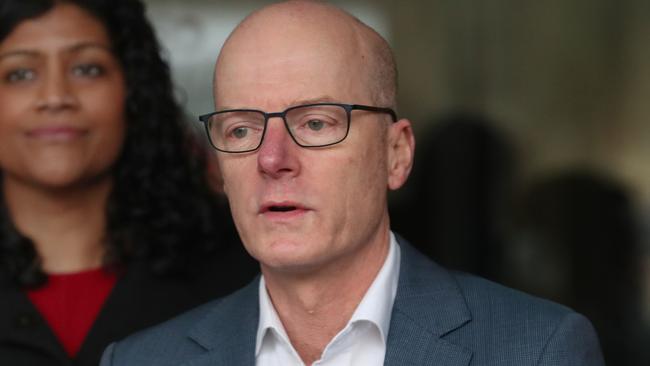Ambulance Victoria calls code red as Covid surges
Ambulance Victoria was forced to call a code red in Melbourne as it struggles with huge demand due to a growing Covid wave.

Victoria
Don't miss out on the headlines from Victoria. Followed categories will be added to My News.
Ambulance Victoria was forced to declare a code red in metropolitan Melbourne in the early hours of Saturday morning to help cope with extreme demand.
In a statement, paramedics confirmed some “lights and sirens” emergency calls were delayed during the period.
The emergency response escalation was called at 11.59pm on Friday night and withdrawn at 3am.
During a code red event, non-emergency ambulances begin responding to emergencies, patients are rapidly offloaded at hospitals and non-urgent patients are referred to other services.
But despite the “extreme” demand overnight, Ambulance Victoria on Saturday said they are not aware of any dire outcomes.
Metropolitan regional director Michael Georgiou said at this stage services had seen “no adverse outcomes”.
It is not yet known if urgent category patients were forced to wait more than the 15-minute benchmark average.
“I’m not across that specific detail but what I do know is those lights and sirens cases … we were able to dispatch ambulances within minutes once we had our escalation plan,” he said.
Mr Georgiou said there were more than 1250 ‘lights and sirens’ cases overnight.
“It is well and truly above our demand,” he said.
“Last month we had our highest volume of code one lights and sirens cases in history.
“We had 11 days in a row with over 1200 cases per day.”
One code red and 17 code oranges have been declared in November this year.
Mr Georgiou said he was unsure whether another code red would be called this weekend.
“Nothing is heading that way at this point in time but as I said, we can’t predict our demand in the community,” he said.

Earlier, an Ambulance Victoria spokesman said the organisation had a “detailed Emergency Response Plan and escalation procedures to effectively manage a surge in workload and demand”.
“These measures quickly reduced the impact on our services and freed up ambulances for patients in the community early this morning,” they said.
“Staffing challenges due to Covid-19 and increasing workload resulted in limited availability of ambulances with some ‘lights and sirens’ emergency calls being delayed.
“All measures we take during a red escalation are aimed at getting to the sickest patients as quickly as possible, which is always our priority.”
Ambulance Victoria has about 140 paramedics furloughed due to Covid-19, which has increased from about 30 at the start of October.
The spokesman warned that Victoria’s already-struggling health system will continue to face challenges over the coming weeks.
“It is important that everyone uses ambulances and hospitals responsibly so that the sick and vulnerable can be adequately cared for,” they said.
“We thank the community who heard and shared our messages and helped us resolve this matter overnight.”
Ambulance Union boss Danny Hill said the health system was under strain.
“We are back to 600 Covid cases in hospital, over 1400 health workers furloughed including over 100 paramedics,” he said.
“Members are still saying the majority of calls they are sent to don’t require any form of paramedic treatment. But perfect for GP respiratory clinics.”
Summer leave up in air for healthcare workers
Hospitals will have the power to cancel staff leave from Saturday, as authorities place Victoria’s health system under new measures to combat “increasing demand” amid a fourth Covid wave.
The state will move to stage three of a four part plan, which lists a series of measures ranging from increased telehealth to at the most serious, final stage, suspending elective surgery.
It comes as Victoria’s Covid hospitalisations hit their highest daily number since August.
A health department spokesman said there were currently no plans to move stage four or code brown – at which point elective surgery can be suspended.

But the escalation to stage three does signal the health system is under pressure and means individual health services can – if needed – cancel staff leave and telehealth appointments are encouraged.
The department announced the move in the Chief Health Officer update issued late Friday afternoon, citing the “increasing demand on the Victorian public health system”.
“This is a reflection of both high numbers of people with Covid in hospital, particularly across our metropolitan health services, as well as ongoing furlough challenges at all sites leading into the holiday period,” the update stated.
“The Health System Response Framework (previously known as the Health System Winter Response) (HSR) will be escalated to Stage 3, effective Saturday 3 December 2022.”
“This will enable the enhanced application of levers to best use resources, facilitate load balancing and generate capacity in order to relieve system pressures. The Health System Response was developed to provide the Victorian acute health system a strategy to maintain high quality Covid-19 and non Covid-19 care, including elective activity.”
Restrictions ‘would not help’: Covid experts
The “escalation” comes after Covid hospitalisations rose by more than 28 per cent in the past week.
The Victorian Greens on Friday morning called on the state government to consider the reimposition of restrictions to try and beat back the surging case numbers and hospitalisations.
Victoria recorded more than 26,000 cases in the past week — a 20 per cent increase — while hospitalisations have averaged 550 patients a day.
But this is below the Victorian peak last summer, when the Omicron strain and opening of international borders saw daily case numbers peak at more than 51,000 and hospitalisations exceed 1100 patients.

Deakin University epidemiology chair Professor Catherine Bennett said there were multiple variants circulating now — as opposed to one dominant one — which tended to lead to “patchy” outbreaks instead of sharp increases.
“This poly-variant outbreak is different from what we have seen before.
“I don’t think we’re going to have a much higher peak hopefully.”
Monash University epidemiologist Associate Professor James Trauer said case numbers could potentially peak next week, meaning intensive care admissions and deaths may increase slightly afterwards, but he wasn’t “as concerned” compared to previous waves.
“I think it’s very unlikely we’re going to see the severe outcomes and the deaths and the ICU admissions get anywhere near as high as what we saw over the summer, and then with the BA.5 wave through the middle of the year,” he said.
“The epidemic is obviously a lot bigger than what we’re capturing now.
“But we’re much better protected by immunity, and you see that in the (lower) deaths because people had all these multiple rounds of vaccination, and then potentially multiple rounds of exposure and infection.”
Professor Catherine Bennett said hospital numbers showed rates of severe disease were lower.
“We’re not seeing as many people in ICU, as we did for the same number of cases in hospitals back when we last had this number, for the B.A2 wave,” she said.
“We are seeing less impact with each wave, which is also what’s been seen overseas.
“Even if it keeps rising for a week or two, I think it will continue to rise at this low rate of 20 per cent, thankfully, and not tenfold, and that will progressively taper.”
Professor Trauer said this was the pattern seen in epidemics, with each wave of infections less severe than the previous one, and he doesn’t think restrictions would help at this stage.
“It gets milder and milder as you build up this population immunity,” he said.
“I just don’t see the drive to reduce transmission is going to have a big impact.
“It’s really immunity that’s protecting us now.
He said encouraging mask use across the community is “just not as effective” as vaccination and antiviral campaigns now.

“For people who are really vulnerable, I think reducing contact and wearing masks over the course of the next couple of weeks is useful, but I just don’t see that there’s going to be a huge impact of trying to get the whole community to,” he said.
That doesn’t mean the health system is entirely free from the pressure of Covid, with paramedics pointing to Covid-linked staff shortages as a factor in Ambulance Victoria’s code orange late last month.
The Herald Sun understands the number of staff furloughed due to Covid has more than tripled since the start of October, with about 100 staff off work as of last week.
Professor Bennett said even though some of the Covid hospital figures represent Covid-positive people hospitalised for other illnesses, it still leads to an increased workload, and that it was important high-risk settings such as aged care were monitored.
“Even if you’ve got people there who’d be in hospital anyway, and they’re not adding more people to the hospital system … you’ve still got the infection control challenges,” she said.
“So it does always put stress on hospitals.
“We have a lot of very fatigued healthcare workers who are overdue to take leave, and so you rely on the quieter times (such as summer) to allow people to take leave.
“So it is important to watch hospital rates as always, but we could cope in winter and we will cope now.
“We just have to unfortunately.”
Greens call for masks, density limits
The Victorian Greens have called on the state government to consider the reimposition of Covid restrictions.
With Covid cases rising, including the number of hospitalisations, Greens spokesman Tim Read called said it was time for the government to act.
Mr Read said the government should be promoting mask wearing and improving indoor air quality, particularly where people are eating or drinking.

And he said the government must also be prepared to adopt other measures to reduce Covid transmission, including density limits or compulsory masks on public transport.
“If we’re serious about helping our ambulance and hospital system, we can’t keep watching these numbers increase without doing something,” he said.
“Victoria went into this pandemic with fewer hospital beds per capita than NSW and after years of coping with thousands of Covid cases and Covid-induced staff shortages, our health workers are exhausted.
“Unless we retain some basic public health measures there will be nothing to slow the next increase in Covid which may not be far away.
“Asking Victorians to mask up in indoor spaces, use an air purifier or have a Covid booster, is preferable to asking them to wait longer for an ambulance or a hospital bed when they need one.
“We can’t sleepwalk towards another health crisis.”




